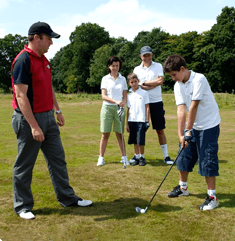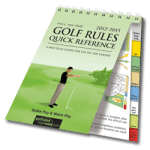Contents
How to achieve more distance?
Aditya Govindaraj of Madras, India writes: I have a lack of distance off the tee, despite hitting the ball crisply. How can I achieve more distance off the tee ?
Scott Robbins:
Dear Aditya,
The ball flight laws that deal with distance are centerness of the hit and speed. Since you say you hit the ball crisply, then you need to concentrate on speed.
Speed comes from the momentum the club generates in the swing. The farther the clubhead can travel, the more momentum it can generate. The measurement of momentum is called speed. Therefore, you can experiment with different ways to create more momentum. Equipment wise, experiment with longer drivers and different loft trying to find the right combination of carry and roll to help increase your total length off the tee.
Increasing the width and size of your swing arc (the circle the clubhead makes around your body in the swing) is the best way to do this. Once you have made the swing as wide as long as you can, then you can attempt to increase the rate or tempo that your body moves through the hitting area. However, studies have shown that there is not much a golfer can do to increase his/her clubhead speed significantly.
However, yours will. As you grow, your arms and legs will get longer and that will help increase the size of your arc.
Wanting to increase distance, though can come with less accuracy. As you attempt to hit the ball further, you may lose accuracy through mishits on the clubface. Therefore, experiment with hitting the ball further or do as all of us did as we played through our growing years. Play with the distance you hit it now, concentrate on accuracy and your short game because as you grow and your distance naturally increase, your scores will drop quickly.
Good Luck,
Scott
Topping the ball
Craig Miller of Cabin John,Maryland writes: I’m topping the ball too much. Can you give me some tips?
Scott Robbins: Craig,
What a great age (6) to be already playing golf. You will have memories of this time for your whole life.
Topping the ball can come from many areas. Something is happening in your swing to lose sight of the ball as you swing into the ball. Therefore, I want you to try a little experiment. When you go practice take with you a crayon or a marker. Draw a face, circle or whatever you want on the ball. When you set the ball down, put the drawing on the back of the ball slightly facing you. Then concentrate on seeing the club hit that drawing and then check to see if you did by checking the clubface after you hit your shot.
Good Luck and I look forward to seeing your name on the PGA Junior Tournament series when you are 14-18 years old.
Scott
Thinking positive
Joey Greive of Ft. Lauderdale writes: I’ve been playing golf for about 11 years now and I was wondering if you could give me some advice on how to keep thinking positive out on the course after I hit a bad shot. I also need some help on how to keep my drives straight and away from trouble. I’ve tried everything up to weakining my grip.
Scott Robbins: Joey,
You have been a busy young man since you could walk playing golf, haven’t you?!
Staying positive on the course comes from two things. First is accepting that you will not hit every shot good and therefore can expect to hit some bad shots, just like the Tour professionals. Secondly, find a swing routine, trust it and stick to it so that when you hit a bad shot you have something to go back to that you know will produce a good shot. Try and use it every time with every shot, from drive to putts.
That will also help you keep drives away from trouble. One part of a good routine is focusing on a target. When you are hitting practice balls and/or on the course, find your target, focus on it and make everything else around it fuzzy in your mind (especially that “trouble”) and trust your swing to hit the ball at that target, just like hitting a wedge or 9 iron at a target.
I know Ft. Lauderdale has some PGA Professionals who could help you with your game. Find one you like and you think can help you improve your ball striking and get with him/her to improve your swing.
Good Luck,
Scott
Building a putting green
Andrew Klug of Carlsbad,CA writes: I am trying to build a putting green in my backyard and I wondered if you knew of any companies that put out intructions for this type of thing?
Scott Robbins: Andrew,
What a neat idea! The name I am going to give you though is not a company but the USGA, the United States Golf Association.
Write them at Golf House, Far Hills, New Jersey 07931 or call them at (908)234-2300 and ask them for some specifications on building a putting green. You will need to talk to the Greens Section.
Good Luck. I would like to hear how it comes out!
Scott
Backspin
Justin Miller in Cabin John, Maryland writes: I’m having trouble getting back spin off the fairway With by nine iron could you please give me some tips on getting the ball to sit. I’m a twenty two handicap
Scott Robbins: Justin,
Backspin comes from proper striking of the ball and clubhead speed. The more clubhead speed and the more in the middle of the clubface you hit the ball, the more spin you will impart on the ball.
Look at your clubs and see where the ball is hitting the club. Try starting, then, with short swings and feel like you are sweeping the ball off the ground with your 9 iron and making sure you are hitting the ball in the center of the clubface.
If you have a brother named John who is 6, I suggest you go ask your Dad to take you to a local PGA Professional who can both you and your brother learn to hit the ball in the middle of the clubface with a sweeping swing.
Good Luck,
Scott Robbins
Which hand is more important?
David Melancon in Hahnville, Louisiana writes: I was always told that the left hand is the most important in the swing but I was recently told by J.C. Snead at a clinic that my right hand is the most important. can you help me?
Scott Robbins: Dear David,
I believe that the hands have two functions in the golf swing. First, and not necessarily in importance, is that the hands align the clubface with the body, more specifically, the spine. Secondly, the hands act as a connector between the club and the big muscles of your body in your shoulders, trunk and legs. Therefore the hands need to properly align the clubface with your swing mechanics and hold on to the club throughout the swing to be able to transfer the energy you generate with your body to the ball.
Which hand then is more important? Neither and both. They need to work together as one unit and they each have their separate functions.
Find a PGA Professional to help you work on your swing and quench your thirst for knowledge by reading as many books as you can, concentrating on the explanations and the different ways the fundamentals of the golf swing are conveyed.
Good Luck,
Scott
Getting nervous
Mark Tanner in Gaitherburg, MD writes: I have a little trouble when I am shooting really well, and I am coming to the last 3 or 4 holes of the round I get nervous and try to play to conservitive and end up shooting 3 or 4 strokes higher.
Scott Robbins: Mark,
What a fabulous question. It is what playing golf is all about. Golf is about dealing with each situation on the course individually yet knowing how your are trying to influence in the whole picture. How do you continue to play well and keep your scores from ballooning in the last few holes. The best way is to keep yourself in the present.
What has happened in the round earlier (the past) cannot be changed and what the final result (the future) of the round is unknown until it is played out. So the only thing you have is the present. Therefore, create a routine, both physically and mentally that you will use to hit every shot and do that. Use it to hit every shot.
What will happen is that instead of thinking about your score coming in to the last few holes, you will only be thinking about hitting the shot you need to hit at that moment on that tee or out of that fairway or rough or hazard or on the putt on the green you are preparing to play. You will be using the same things that got you to the last few holes in position to score well to execute and hit those same shots and finish your round the same way you started it and played it until those last few holes. You might find when you do that, you will become unaware of where you stand in relation to par and what score you are in the process of posting.
Another way to put this is like the math test you will take in school next week. You won’t know your score till you have solved every equation. You won’t concentrate on the final score until after you have gone through the process of completing every problem on the test. Therefore, in your golf as in your math test, if you concentrate on the process, the result will come and be what it is suppose to be.
Good luck. Keep enjoying this challenge we call golf.
Scott Robbins
Fake golf product
Justin Tystad in Dickinson ND writes: I am a student at Dickinson State University in North Dakota. I am an avid golfer but only when it isnt snowing. I know that this sounds kind of odd but I am enrolled in a Business Communications Class here and we have to sell a product to our teacher. My made up product is a golf head cover that looks like the golfer. For this fake company I ask for a picture and we make the golf head cover to look like the person (or close) What I am asking for is a fake endorsement letter saying how good these are. I am not with a real company and I am not going to market this product for real. Thank you
Scott Robbins: Dear Justin,
I do not have a picture to send you but I suggest you get a friend to dress like a golfer and take a snapshot of him holding a club or whatever you need. From the letter standpoint, here goes (with the total understanding that this is a fictitious endorsement letter):
“I first got this headcover as a gift from my children and thought it was a cute novelty. What I have discovered is it’s therapeutic and psychological powers it can have for the golfer. As an instructor I am asked by many of my students how can they concentrate more thoroughly on the golf course. After many discussions and rehearsals, I discovered that by looking at this headcover that looks like a golfer, it serves a great purpose of reminding the golfer that every time he/she takes a club from their bag that they are on the golf course and they need to focus on the task at hand.
I turned around and gave both of my kids a headcover for their driver and their scores immediately began dropping. They both told me the reason was every time they looked at the headcover they immediately thought good thoughts, concentrated on the very next shot instead of a past or future shot or hole, and could hear my voice coaching them through the routine of hitting a good shot. I now stock these
Hitting the ball square
Tim Appledorn of Franklin, IN writes: I play college golf for Franklin College in Indiana. Right now I average 39 and I’m playing second team as a freshmen. What I want to know is I have this difficulty of hitting the ball square on the club? What should I do?
Scott Robbins: Tim,
Congratulations on making the college team. That is an accomplishment in itself!
To hit the golf ball solid, your swing plane must be repetitive and correct. If your plane is off you will hit the ball somewhere on the face other than center and hit the ground either behind or in front of the ball instead of the ball. A couple of things to start with. Check your set up and after you are set try to hit chips with just your shoulder and trunk rotation. From there, increase the length of your swing with a slow tempo, continuing to concentrate on hitting the back of the golf ball.
More importantly, have your coach work with you or go find a local or near PGA Professional and get a few lessons. Good Luck on a productive collegiate career.
Scott
Changing backswing
Chris Taylor in St.lucia, West Indies asks: If my old swing was producing straight and accurate shots most of the time and I was told by a coach from Europe to change my backswing in to something not natural, therefore having to think about my swing as I am doing it, do you think I should listen to the coach or should I use my old swing since it was very consistent and I could rely on it under pressure?
Scott Robbins: Chris, Changes in golf swings are very difficult. When touring professionals consult their coaches, they usually do not have a lot of time to work on those changes between tournaments so they will hit lots of balls to get the swing change in.
However, the physical change happens faster than the mental change does. What I mean by that is that after all the practice they have to go play with the new changes and trust that they will work on the golf course. It takes a while to learn to trust it on the course and therefore build confidence in the swing.
A good example is PGA Champion Mark Brooks. Mark was struggling with old swing habits in April and worked with his coach, Doug Higgins, Jr. at The Masters. He later in May won the Houston Open and in August he won the PGA Championship.
Trust between player and coach is important. If what your coach is changing is occasionally producing better golf shots, then work with it. Swing changes and new moves don’t immediately produce better golf shots but if you are seeing some better shots, stick with it. Once the change gets in, your golf game will be more reliable and pressure proof.
Good Luck, Scott
Ball compression
Terry Ford in Australia asks: What ball compression would suit my game best? I currently play of 22.
Scott Robbins: Terry,
There are so many balls out now, you will need to experiment. The best for you will probably be a two piece construction ball. If you hit the ball low, find one designed to fly higher. If you hit it high, find one that will fly lower. There is more than compression that you need to be concerned with, therefore, experiment with different balls.
Scott
New clubs
Dave Newman of Edmonton, Alberta, Canada writes: I am a 3 handicap that is an avid competitive golfer in my province. Recently I have decided to purchase new irons but I am confused. What is better, blades or forgiving clubs? What are the advantages and disadvantages of either? I was told that with blades, a junior such as myself can be more accurate, and improve more easily. But if forgiving clubs are easier to hit, wouldn’t that be the way to go? Please clear my confusion on the subject.
Scott Robbins: Dave,
Golf equipment at your level of play becomes very, very important. The most important factor in the club is the shaft. Be sure you are fit with the proper shaft to fit your swing. Otherwise you will be adjusting your swing to fit your clubs.
The feel you will have is not to do with the head design but to do with the shaft. However, head design can be beneficial. Any design will produce the best shot when it is hit in the center of the club (again has more to do with the shaft) but a cavity back design will give you a little more room for error.
There are cavity back forging and cast clubs. Either one will do as long as the clubs are made by a major manufacturer and the manufacturer pays close attention to consistent weighting of the heads.
Three recommendations in fittings and clubs would be Mizuno, Titleist DCI irons and Slazenger. Good Luck. Be sure those clubs fit your swing!
Scott







